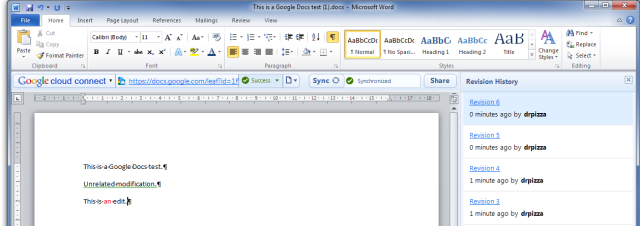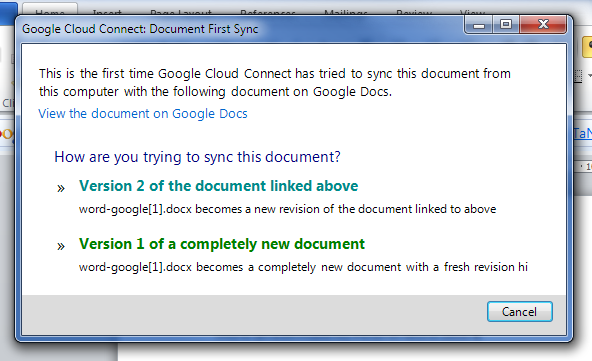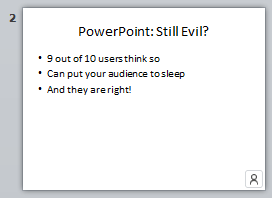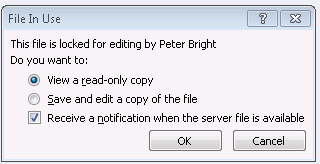Google Docs, the online suite of productivity applications, has long offered collaborative, cloud-based sharing and editing of office-type documents. A new add-in for Microsoft Office, Cloud Connect, now extends the reach of that online offering to the world of traditional desktop applications.
The add-in, for Office 2003, 2007, and 2010 (both 32- and 64-bit versions) enables cloud syncing and collaborative editing of Word, Excel, and PowerPoint documents. In doing this, it is competing head-on with Microsoft's own collaboration features found in Office 2010, SkyDrive, and SharePoint. Microsoft has promoted collaborative editing as one of the major features of Office 2010, and both companies clearly think that this model of concurrent editing is going to become increasingly common. We took a look at Google's plug-in against Office 2010's native collaboration features to see if it's all it's cracked up to be.
The Google plug-in installs a thin toolbar in each supported application. The toolbar shows the sync status of each document, its Google Docs URL, and a toggle to switch between automatic syncing and on-demand manual syncing. For the most part, it is designed to be transparent. If left in automatic mode, any document saved locally will automatically be uploaded to Google Docs every time you hit save. Saving the document for the first time gives it a Google Docs URL, which can then be shared around to enable collaboration.

To open the document in Word, it must be downloaded and opened up. Cloud Connect embeds metadata within each document to allow the plugin to recognize that the document can be synchronized (the privacy conscious can elect to remove this metadata, but doing so breaks the association with Google Docs and hence ends the ability to sync and share changes). On saving the document for the first time after opening it, you are asked if you want to save as a new version of the existing document, or as version one of a new document. Choose to save as a new version, and away you go: multiple people can edit the document concurrently.

In use, the experience is a little unnerving. There's no apparent indication that someone else has the document open or which section they're working on. New words just appear from nowhere whenever the document syncs. The lack of interface is something of a liability; it makes it very easy to step on each other's toes and make conflicting changes.
In theory, conflicts are handled by giving you the choice of which edit to pick. In practice, we found a variety of behaviors occurred, none of which were correct. Sometimes one document would simply fail to sync, being permanently broken until a fresh copy was reopened from the server. Other times it would sync and merge the edits together. The most common result was that one set of edits would end up clobbering the other, with the winner picked apparently at random. Without careful coordination, data loss seems inevitable.
Word 2010's native collaborative editing worked a lot better. Word gives an indication of how many people are editing a document simultaneously: changes are unlikely to ever catch anyone by surprise, since even as they work on the document, they know that modifications are being made by others. More significantly, Word both shows where in the document others are working, and locks those paragraphs for the duration of their editing. This gives a clear indication of who is doing what, and means that conflicting edits are much less likely to occur. For larger, more expansive edits, sections can be manually locked. Where Google's Cloud Connect is chaotic, Word 2010 is coordinated.


Word 2010 also feels more integrated with other Microsoft offerings. For example, it's easy to send an e-mail or instant message to anyone else editing the document via their contact card. Google provides no indication of who is working on a document, much less any facility to talk to them via Google Talk. Cloud Connect may connect to the cloud, but only a small part of it.

The situation in PowerPoint is similar. We found Cloud Connect to be inconsistent, and the lack of real feedback to indicate that multiple people were working on a document led to surprises. Syncing was fine when it worked (if a little surprising to have slides and text appear from nowhere), but didn't always seem to work, with one machine claiming to have successfully saved changes but the other machine being unable to see those changes for many minutes.
PowerPoint 2010, as with Word 2010, has in-built support for concurrent editing, though it is much less fine-grained than Word. PowerPoint shows a small indicator over a slide if another person is editing it, and it has the same list of concurrent editors as Word 2010, but this is all; PowerPoint lacks any equivalent to Word's fine-grained locking feature.
It's with Excel that Google's offering has the most to offer. The Excel 2010 desktop client has no built-in collaboration features at all; only one person may edit the file at a time. Others are offered only a read-only copy, along with a notification when the file becomes available for editing, in common with previous versions of the software.

Cloud Connect has no such restriction; multiple editors can work on a single spreadsheet with ease. However, the same problems that plague PowerPoint and Word equally affect Excel; inconsistent, slow syncing, clobbered modifications, and so on. It was nice enough when it worked. It just didn't work often enough.
Syncing problems were not the only issues we experienced. On a number of occasions the plug-in crashed or hung the applications we were using; it was not stable enough to be safely usable day-to-day. It is perhaps a little ironic that one of the Google products that's not described as a beta was in practice less reliable than many of the company's products that are labelled as such. If it were stable then I would be inclined to keep it around for the occasional convenience it offers: as it is, I'm going to remove it immediately, because I can't stand for it to crash the programs I'm using.
There is, of course, another side to the cloud connectivity—Web-based editing. The files stored in Google Docs, SkyDrive, and SharePoint can all be edited using the Web-based editors that those services provide. Here again the experience was varied. In a rather peculiar reversal of the desktop situation, Office Web has no provisions for concurrent editing of Word or PowerPoint documents. They operate on a lock basis, with only one user—either online or on the desktop—allowed to make changes at a time. Excel Web, however, allows multiple users to edit in-browser. Why this should be possible in the (dumbed down) Web client but not the fully featured desktop client is beyond me.
Google Docs is unable to edit any of the Office files. It has an online viewer, but no editor. But it doesn't really make this clear; if you tell it to edit an Office document rather than, say, telling you that it can't, it just quietly converts the document to a native Google Docs file, and lets you edit that. This means that your edits are now divorced from the original file—there's no provision to merge them back to the Office document. This is sure to annoy more people than it assists. If you've installed Cloud Connect and intend to use Office, quietly making changes that no longer live in the Office world is totally unhelpful.
All in all, we're left with the feeling that Cloud Connect is a not-even-version-1 product. Even when working at its best, its user experience was crude and unpolished—and much of the time, it didn't even work at its best. Google is positioning Cloud Connect as an alternative to SharePoint that avoids the expense of Office 2010. Unfortunately, it does so at the expense of being usable and useful. Unless you simply must use Office 2003 or 2007—or are desperate for collaboration in desktop Excel even if it doesn't work very well—take a pass on this one.
reader comments
50